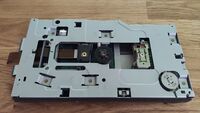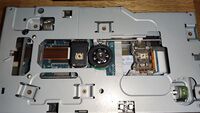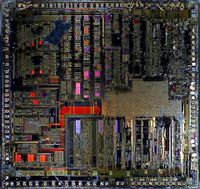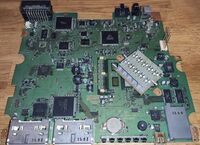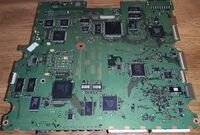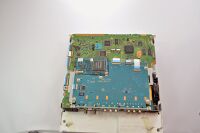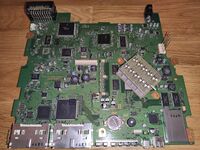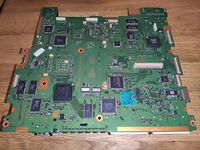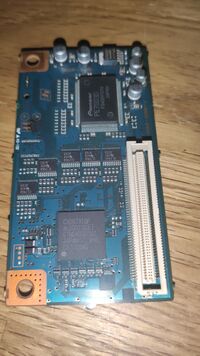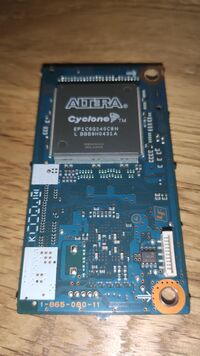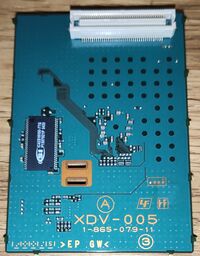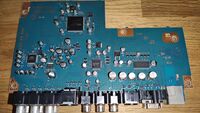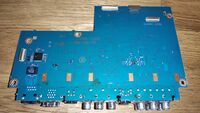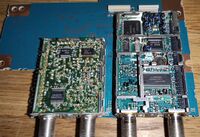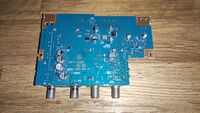PSX: Difference between revisions
(→Notes) |
No edit summary |
||
| (51 intermediate revisions by 7 users not shown) | |||
| Line 1: | Line 1: | ||
This page collects information on the PSX - not the PlayStation (1), but the | This page collects information on the PSX - not the PlayStation (1), but the Japan-only PS2 variant with advanced multimedia and DVR-functions. Being a hybrid of a DVR and a game console, it has a lot of unique traits. Sadly, it has a lot of reliability issues, most notably nowadays dying Hard Drives and Disc Drives. This article aims to make repair easier and collect information that might help in circumventing the HDD vendor-lock in the future. It also aims to be a general collection of information on reverse-engineering of the PSX. | ||
== Models == | == Models == | ||
The PSX was released in eight retail configurations during its lifespan (nine, if you count the silver DESR-5100S); the 5000 series (with an embossed logo on top | The PSX was released in eight retail configurations during its lifespan (nine, if you count the silver DESR-5100S); the 5000 series (with a solid white case and an embossed logo on top) shipped with 160 GB Hard disk drives, while the 7000 series (with a more premium acrylic outer case, a colored logo on top and black stripe with blue LED strip at the back) contained 250 GB drives. Software updates were made available by disc and download. | ||
{| class="wikitable" style="text-align:center; margin: 1em auto 1em auto;" | {| class="wikitable" style="text-align:center; margin: 1em auto 1em auto;" | ||
| Line 16: | Line 14: | ||
!rowspan="2"|FireWire | !rowspan="2"|FireWire | ||
!colspan="2"|VHF/UHF tuner | !colspan="2"|VHF/UHF tuner | ||
!colspan="2"|BS tuner | !colspan="2"|BS tuner<br/>''analog only'' | ||
!rowspan="2"|Memory Stick video export | !rowspan="2"|Memory Stick video export | ||
!rowspan="2"|Writable disc formats | !rowspan="2"|Writable disc formats | ||
| Line 30: | Line 28: | ||
!In | !In | ||
!Out | !Out | ||
|- | |||
!colspan="17"|First generation (PSX1) | |||
|- | |- | ||
|DESR-5000 | |DESR-5000 | ||
| Line 65: | Line 65: | ||
|1.31 | |1.31 | ||
|99 800 ¥ | |99 800 ¥ | ||
| | |December 13th 2003 | ||
|- | |- | ||
|DESR-5100 | |DESR-5100 | ||
| Line 120: | Line 120: | ||
|95 000 ¥ | |95 000 ¥ | ||
|July 1st 2004 | |July 1st 2004 | ||
|- | |||
!colspan="17"|Second generation (PSX2) | |||
|- | |- | ||
| DESR-5500 | | DESR-5500 | ||
| Line 202: | Line 204: | ||
== Onboard flash == | == Onboard flash == | ||
The PSX has a flash memory on board called xfrom, containing the xosdmain.elf XMB-executable and some other files. xosdmain.elf is always located at xfrom:/BIEXEC-SYSTEM/xosdmain.elf. The other files differ between PSX1 (DESR-x000 and DESR-x100) and PSX2 (DESR-x500 and DESR-x700). Their main purpose is setting a boot mode for xosdmain.elf. On PSX1, several files get temporarily created to configure the boot mode. On PSX2, this is handled by a single file named bootflag.txt. | The PSX has a flash memory on board called xfrom, containing the xosdmain.elf XMB-executable and some other files. xosdmain.elf is always located at xfrom:/BIEXEC-SYSTEM/xosdmain.elf. The other files differ between PSX1 (DESR-x000 and DESR-x100) and PSX2 (DESR-x500 and DESR-x700). Their main purpose is setting a boot mode for xosdmain.elf. On PSX1, several .opt files can get temporarily created (or deleted) to configure the boot mode. On PSX2, this is handled by a single file named bootflag.txt. | ||
== File types == | == File types == | ||
''This list is incomplete.'' | ''This list is incomplete.'' | ||
* OPT: .opt files are behavior switch tokens used on PSX1 (DESR-x000 and DESR-x100). They were first used on the HDD-OSD (Browser update bundled with HDD utility disc to browse HDD). The XFROM bootloader is capable of using such files to perform certain tasks in case the XMB becomes unresponsive or doesn't boot. The contents are not important, however, Sony seemed to make them 512bytes filled with 0xff. They're expected at the program CWD (xfrom:/BIEXEC-SYSTEM for this case) | |||
The following file tokens have been confirmed: | |||
{| class="wikitable" | |||
|+ Caption text | |||
|- | |||
! File !! Purpose | |||
|- | |||
| repartition.opt || repartitions the DVR area? | |||
|- | |||
| make_game_area.opt || Resizes PS2 HDD area to 40gb? (Needs repartition.opt) | |||
|- | |||
| contents.opt || unknown | |||
|} | |||
* PAK: encrypted archive format that stores update data. Can be found on the [[PSX Update Disc]]. Has been reverse engineered and decryption/unpacking is [https://gist.github.com/balika011/7bb704cf591e40bd364a1c0a5018bc5b possible]. | * PAK: encrypted archive format that stores update data. Can be found on the [[PSX Update Disc]]. Has been reverse engineered and decryption/unpacking is [https://gist.github.com/balika011/7bb704cf591e40bd364a1c0a5018bc5b possible]. | ||
* REL: encrypted package binaries found in PSX packages. Has been reverse engineered and decryption/unpacking is [https://gist.github.com/balika011/220dd4147ddc2a32efbaedfb8ebcd387 possible]. | * REL: encrypted package binaries found in PSX packages. Has been reverse engineered and decryption/unpacking is [https://gist.github.com/balika011/220dd4147ddc2a32efbaedfb8ebcd387 possible]. | ||
| Line 317: | Line 333: | ||
==== 160 GB ==== | ==== 160 GB ==== | ||
* Seagate "U Series 9" ST3160022ACE | * Seagate "U Series 9" ST3160022ACE | ||
* Maxtor "DiamondMax 9" | * Seagate "DB35.3" ST3160215ACE (from a DESR-5000 serviced in 2007) | ||
* Maxtor "DiamondMax Plus 9" 6Y160P0 | |||
* Maxtor "DiamondMax 10" 6L160P0 | * Maxtor "DiamondMax 10" 6L160P0 | ||
==== 250 GB ==== | ==== 250 GB ==== | ||
* Hitachi "DeskStar" HDS722525VLAT80 | * Hitachi "DeskStar" HDS722525VLAT80 | ||
* Seagate "Barracuda 7200.10" ST3250820A (from a DESR-7000 serviced around 2008-2009) | |||
* Maxtor "MaXLine Plus II" 7Y250P00609BH | * Maxtor "MaXLine Plus II" 7Y250P00609BH | ||
== Disc Drive == | == Disc Drive == | ||
The PS2-part of the drive is based on the H/I chassis SCPH- | The PS2-part of the drive is based on the H/I chassis SCPH-500xx/5500x fat PS2 drive, both electrically and mechanically. The whole drive assembly is connected to the motherboard using 3 flat flex cables: One is an IDE connection to the dedicated drive board of the PSX-part, one provides power (5V, 12V, GND) and also connects the PS2-part sled motor to the motherboard (since it is controlled by the motherboard directly), and one connects the [[KHS-400C]] PS2-part pickup to the motherboard, since it is also directly controlled by the motherboard. The spindle motor is always controlled by the dedicated PSX-part drive electronics over IDE, even in PS2 mode. | ||
Two different models have been made; the older one is used in DESR-x000 and x100, the newer one in DESR-x500 and x700. The drive has an updatable firmware for the PSX-mode part of the drive; at least the newer drive actually received such an update (Sony model name: DW-DX02A, known firmware versions: 0YX7 Sep 15 2004, BV1M Mar 08 2005). | Two different models have been made; the older one is used in DESR-x000 and x100, the newer one in DESR-x500 and x700. The drive has an updatable firmware for the PSX-mode part of the drive; at least the newer drive actually received such an update (Sony model name: DW-DX02A, known firmware versions: 0YX7 Sep 15 2004, BV1M Mar 08 2005). | ||
* DESR-x000 and DESR-x100 drive | * DESR-x000 and DESR-x100 drive | ||
** Uses Sony KWS-200A optical pickup | ** Uses Sony [[KWS-200A]] optical pickup | ||
[[File:8UIuNSN.jpg|200px]] | |||
* DESR-x500 and DESR-x700 drive | * DESR-x500 and DESR-x700 drive | ||
** Uses Sanyo SF-DB11 optical pickup | ** Uses Sanyo [[SF-DB11]] optical pickup | ||
[[File:XkMxA6G.jpg|200px]] | |||
=== Integrated Circuits (MA-S38, used in DESR-x000 and DESR-x100) === | === Integrated Circuits (MA-S38, used in DESR-x000 and DESR-x100) === | ||
[[File:8GcBpTO.jpg|200px]][[File:tFQSjoP.jpg|200px]] [[File:le4VpFe.png|200px]]<br/> | |||
Block diagram of closely related sony drive DRU-500A using the exact same chipset and optical pickup above. | Block diagram of closely related sony drive DRU-500A using the exact same chipset and optical pickup above. | ||
* Digital | * Digital | ||
| Line 351: | Line 369: | ||
** NEC uPD68812 (chip marking: 68812 Y02) (analog & servo) | ** NEC uPD68812 (chip marking: 68812 Y02) (analog & servo) | ||
** Sony CXD9711R (front-end/signal processor/ IC for laser unit, no public datasheet available) | ** Sony CXD9711R (front-end/signal processor/ IC for laser unit, no public datasheet available) | ||
** | ** [[File:RFGGpWE.jpg|200px]] | ||
* Analog | * Analog | ||
** Rohm BD6670FM (3-Phase spindle motor driver for CD-RW) | ** Rohm BD6670FM (3-Phase spindle motor driver for CD-RW) | ||
** Fairchild FAN8035L (6-CH Motor Driver, used as driver for focus, tracking, tilt, sled) | ** Fairchild FAN8035L (6-CH Motor Driver, used as driver for focus, tracking, tilt, sled) | ||
** ST KF25 (2.5V low drop voltage regulator) | ** ST KF25 (2.5V low drop voltage regulator) | ||
** On the pickup: | |||
*** Sony CXA2640ER (laser diode driver) | |||
*** Sony CXA2641N (DVD detector PDIC) | |||
*** GA100TBR (CD detector PDIC) | |||
*** ?? (DVD front power monitor PDIC) | |||
*** ?? (CD front power monitor PDIC) | |||
*** ?? (CD laser diode; internal power monitoring photo diode is unused; external front power monitoring PDIC does power monitoring instead) | |||
**** Specs for reading: 790 nm at 1.55 mW to 1.65 mW (measured on top of the whole pickup, not directly at the LD) | |||
**** Specs for writing: 790 nm at 31.75 mW to 33 mW (measured on top of the whole pickup, not directly at the LD) | |||
*** ?? (DVD laser diode; internal power monitoring photo diode is unused; external front power monitoring PDIC does power monitoring instead) | |||
**** Specs for reading: 660 nm at 0.72 mW to 0.78 mW (measured on top of the whole pickup, not directly at the LD) | |||
**** Specs for writing: 660 nm at 11 mW to 12 mW (measured on top of the whole pickup, not directly at the LD) | |||
=== Integrated Circuits (MA-S43, used in DESR-x500 and DESR-x700) === | === Integrated Circuits (MA-S43, used in DESR-x500 and DESR-x700) === | ||
[[File:SMelZmP.jpg|200px]][[File:bq7vfM1.jpg|200px]] [[File:aSsQnHT.png|200px]] [[File:7a19mhs.png|200px]] [[File:4vJpjgw.jpg|200px]]<br/> | |||
Pinout of debug header above (directly connected to MT1828E). LiteOn PC DVD drives and their Sony OEM equivalents using the same chipset also have a debug connector with this pinout. | Pinout of debug header above (directly connected to MT1828E). LiteOn PC DVD drives and their Sony OEM equivalents using the same chipset also have a debug connector with this pinout. | ||
* Digital | * Digital | ||
| Line 364: | Line 394: | ||
** IC603: Mediatek MT1828E (main DVD-drive/burner controller, includes microcontroller/s, DSP, EnDec etc., no public datasheet available) | ** IC603: Mediatek MT1828E (main DVD-drive/burner controller, includes microcontroller/s, DSP, EnDec etc., no public datasheet available) | ||
*** Pinout available from some PC DVD drive's schematics | *** Pinout available from some PC DVD drive's schematics | ||
*** | *** Has an 80C32/MCS-51 8-Bit microcontroller core as other Mediatek chipsets from that time do. | ||
*** Has a debug header on board; see above for pinout | *** Has a debug header on board; see above for pinout | ||
* ROM and Flash | * ROM and Flash | ||
| Line 374: | Line 404: | ||
** IC103: Mediatek MT1816E (front-end/signal processor IC for laser unit, no public datasheet available) | ** IC103: Mediatek MT1816E (front-end/signal processor IC for laser unit, no public datasheet available) | ||
*** pinout available with example circuit in schematics of some DVRs, see picture above | *** pinout available with example circuit in schematics of some DVRs, see picture above | ||
*** | *** [[File:L14GJ54.jpg|200px]] | ||
* Analog | * Analog | ||
** IC110: Rohm BD6670FM (3-Phase spindle motor driver for CD-RW) | ** IC110: Rohm BD6670FM (3-Phase spindle motor driver for CD-RW) | ||
| Line 381: | Line 411: | ||
** IC403: ST KF25 (2.5V low drop voltage regulator) | ** IC403: ST KF25 (2.5V low drop voltage regulator) | ||
** IC1000: Fairchild FAN8035L (6-CH Motor Driver) | ** IC1000: Fairchild FAN8035L (6-CH Motor Driver) | ||
** On the pickup: | |||
*** Elantec/Intersil EL6833CLZ (Laser Diode driver) | |||
=== Notes === | === Notes === | ||
* Contrary to some information on the internet, the drive does NOT seem to be married to the individual console. It is however likely that you can not replace the older drive type by the newer type or vice versa (needs verification, please contribute), due to different specifications and features, despite identical electrical interfaces (which is just IDE/ATA through a 50 pin flat flex cable). | * Contrary to some information on the internet, the drive does NOT seem to be married to the individual console. It is however likely that you can not replace the older drive type by the newer type or vice versa (needs verification, please contribute), due to different specifications and features, despite identical electrical interfaces (which is just IDE/ATA through a 50 pin flat flex cable). | ||
* Several | * Several variants of the Sanyo [[SF-DB11]] pickup exist, with only some of them being compatible with the PSX. Trying to install an incompatible one will (sometimes? always?) burn the flat flex cable and/or blow the 5V drive-power fuse on the motherboard depending on your luck (known compatible variants: bottom sticker number starts with DB11B; known incompatible revisions: bottom sticker number starts with DB11N, 11NX or 11NXL). It didn't seem to damage anything else though; most notably all electronics (after replacing the blown fuse) AND the laser pickup (after being installed into a compatible PC drive that uses this variant) survived. | ||
** These different types are seemingly actually called "SF-DB11B" (the one compatible with the PSX), "SF-DB11NS", "SF-DB11NX" and "SF-DB11NXL" (all three incompatible with PSX). These are best differentiated by the bottom sticker, not by the embossed revision number on the top. | |||
** These different types are seemingly actually called "SF-DB11B" (the one compatible with the PSX), "SF-DB11NS", "SF-DB11NX" and "SF-DB11NXL" (all three incompatible with PSX). These are best differentiated by the bottom sticker, not by the embossed revision number. | |||
** Symptoms of a blown 5V fuse: | ** Symptoms of a blown 5V fuse: | ||
*** Drive appears dead (the slot-mechanism however still works and correctly pulls in and ejects discs) | *** Drive appears dead (the slot-mechanism however still works and correctly pulls in and ejects discs) | ||
*** When forcing the console into PS2 mode through FMCB, inserting a disc will cause the PS2-laser to start focussing since it runs from another power source, however, the spindle motor will not spin | *** When forcing the console into PS2 mode through FMCB, inserting a disc will cause the PS2-laser to start focussing since it runs from another power source, however, the spindle motor will not spin | ||
*** The front USB port does not work | *** The front USB port does not work | ||
** | ** [[File:jPNVCqr.jpg|200px]][[File:Vo2DfEx.jpg|200px]] | ||
* There is an official documentation of the KWS-200A used in the DESR-x000 and DESR-x100 PSX, released by Sony itself:<br/> | ** Comparison of an compatible type (left) with an incompatible type (right) of [[SF-DB11]] with the bottom shielding removed. Note the missing potentiometers for setting the oscillator frequencies on the incompatible type, where fixed 680 Ohm resistors are used instead:<br />[[File:UJjmXaf.jpg|200px]] | ||
* There is an official documentation of the [[KWS-200A]] used in the DESR-x000 and DESR-x100 PSX, released by Sony itself, however, both power monitoring PDICs are absent in the drawing:<br/> [[File:TxkqxiO.jpg|200px]] [[File:tyimnzA.jpg|200px]] | |||
== Motherboards == | == Motherboards == | ||
=== XPD-001 === | === XPD-001 === | ||
[[File:3VI7Zy4.jpg|200px]] [[File:XYRnjjJ.jpg|200px]] | |||
* Year 2003 - 2004 | * Year 2003 - 2004 | ||
* Models DESR-5000, DESR-7000, DESR-5100, DESR-5100S, DESR-7100 | * Models DESR-5000, DESR-7000, DESR-5100, DESR-5100S, DESR-7100 | ||
* Chassis X | * Chassis X | ||
* Both PSX motherboards have a total of 72 MB | * Both PSX motherboards have a total of 64 MB RDRAM (physical ICs: 72 MB, but not fully utilized), unlike normal PS2s' 32 MB | ||
* Both PSX motherboards have a total of 8 MB EDO-RAM for IOP, unlike normal PS2's 2 MB | |||
* Known sub-revisions: | * Known sub-revisions: | ||
** -21 | ** -21 | ||
===XPD-005=== | ===XPD-005=== | ||
[[File:UMfHEc5.jpeg|200px]] [[File:NdGWHc8.jpg|200px]] [[File:9Y7cnAR.jpg|200px]] [[File:N2KbF4f.jpg|200px]] [[File:GKSod5P.jpg|200px]] [[File:9SQ2pA6.jpg|200px]] [[File:PvN9OVS.jpg|200px]] [[File:7GtTpug.jpg|200px]] [[File:1yxJfmt.jpg|200px]] [[File:JiSqdou.jpg|200px]] [[File:qFytObT.jpg|200px]] [[File:GcPhiw2.jpg|200px]] | |||
* Year 2004 - 2005 | * Year 2004 - 2005 | ||
* Models DESR-5500, DESR-7500, DESR-5700, DESR-7700 | * Models DESR-5500, DESR-7500, DESR-5700, DESR-7700 | ||
* Chassis X | * Chassis X | ||
* Both PSX motherboards have a total of 72 MB | * Both PSX motherboards have a total of 64 MB RDRAM (physical ICs: 72 MB, but not fully utilized), unlike normal PS2s' 32 MB | ||
* | * Both PSX motherboards have a total of 8 MB EDO-RAM for IOP, unlike normal PS2's 2 MB | ||
** One large daughter board (XRC-005) with analog video interfaces as well as the Ethernet transceiver | * Compared to XPD-001, this board has several more daughter boards: | ||
** One smaller daughter board (XCP-005) with the [[SPEED]] | ** One large daughter board (XRC-005) with analog video interfaces as well as the Ethernet transceiver (the much smaller XRC-001 in XPD-001 consoles only contains the s-video/composite input/output ports) | ||
** One smaller daughter board (XCP-005) with one the console's two [[SPEED]] chips, an unknown Pioneer chip (PE7003D) and an Altera FPGA (with it's configuration EEPROM and a programming header) | |||
*** The FPGA likely does AVC/H264 encoding for the PSP/MS video export feature | *** The FPGA likely does AVC/H264 encoding for the PSP/MS video export feature | ||
*** A similarily named Pioneer chip (PE7005A) is found in some Pioneer DVR (DVR-920H-S), where it is labelled as an I/O expander in the service manual | *** A similarily named Pioneer chip (PE7005A) is found in some Pioneer DVR (DVR-920H-S), where it is labelled as an I/O expander in the service manual | ||
| Line 432: | Line 464: | ||
** Has a dedicated NOR-flash located on the other side of the motherboard containing its firmware (Fujitsu MB85431BC) | ** Has a dedicated NOR-flash located on the other side of the motherboard containing its firmware (Fujitsu MB85431BC) | ||
** Probably also functions as some kind of SysCon/SMC, controlling LEDs, IR-receivers etc (needs verification; this might as well be handled by Mechacon and/or IOP) | ** Probably also functions as some kind of SysCon/SMC, controlling LEDs, IR-receivers etc (needs verification; this might as well be handled by Mechacon and/or IOP) | ||
** Related IC is used in some VAIO-Notebooks with an internal Memory Stick reader, where it's called "SUMIRE2" in the schematics | ** Related IC is used in some VAIO-Notebooks (PCG-V505BL/V505BX/V505BXP) with an internal Memory Stick reader, where it's called "SUMIRE2" in the schematics | ||
=== Audio/Video ICs === | === Audio/Video ICs === | ||
| Line 443: | Line 475: | ||
* Fujitsu MB85432BF | * Fujitsu MB85432BF | ||
** NOR-Flash | ** NOR-Flash | ||
** Firmware for [[DVRP]] | ** Firmware for [[DVRP]]; also contains 2 more firmware blobs for other devices | ||
** This is a custom part number by Sony, but the chip seems to match with the Fujitsu MBM29LV320BE, which is a 32 Mbit Flash | |||
* Samsung K9F6408U0C-QCB0 | * Samsung K9F6408U0C-QCB0 | ||
| Line 456: | Line 489: | ||
** Microwire EEPROM (1 KBits/128 Bytes) | ** Microwire EEPROM (1 KBits/128 Bytes) | ||
** Connected to [[CXD9764GP]] (DVR-SPEED) | ** Connected to [[CXD9764GP]] (DVR-SPEED) | ||
** MAC Address and checksum | |||
=== DRAM === | === DRAM === | ||
| Line 466: | Line 500: | ||
** Has a dedicated NOR-flash located on the other side of the motherboard containing its firmware (Fujitsu MB85431BC) | ** Has a dedicated NOR-flash located on the other side of the motherboard containing its firmware (Fujitsu MB85431BC) | ||
** Probably also functions as some kind of SysCon/SMC, controlling LEDs, IR-receivers etc (needs verification; this might as well be handled by Mechacon and/or IOP, please contribute) | ** Probably also functions as some kind of SysCon/SMC, controlling LEDs, IR-receivers etc (needs verification; this might as well be handled by Mechacon and/or IOP, please contribute) | ||
** Related IC is used in some VAIO-Notebooks with an internal Memory Stick reader, where it's called "SUMIRE2" in the schematics | ** Related IC is used in some VAIO-Notebooks (PCG-V505BL/V505BX/V505BXP) with an internal Memory Stick reader, where it's called "SUMIRE2" in the schematics | ||
=== Audio/Video ICs === | === Audio/Video ICs === | ||
| Line 477: | Line 511: | ||
* Fujitsu MB85432BF | * Fujitsu MB85432BF | ||
** NOR-Flash | ** NOR-Flash | ||
** Firmware for [[DVRP]] | ** Firmware for [[DVRP]]; also contains 2 more firmware blobs for other devices | ||
** This is a custom part number by Sony, but the chip seems to match with the Fujitsu MBM29LV320BE, which is a 32 Mbit Flash | |||
* Samsung K9F6408U0C-QCB0 | * Samsung K9F6408U0C-QCB0 | ||
** NAND-Flash (8 MBytes) | ** NAND-Flash (8 MBytes) | ||
** PSX | ** PSX flash for BootLoader (xfrom:/) | ||
* OKI MR27V3202F (printed on chip: R27V3202F) | * OKI MR27V3202F (printed on chip: R27V3202F) | ||
| Line 490: | Line 525: | ||
** Microwire EEPROM (1 KBits/128 Bytes) | ** Microwire EEPROM (1 KBits/128 Bytes) | ||
** Connected to [[CXD9764GP]] (DVR-SPEED) | ** Connected to [[CXD9764GP]] (DVR-SPEED) | ||
** MAC Address and checksum | |||
=== DRAM === | === DRAM === | ||
== Power Supply == | |||
{| class="wikitable" | |||
|+Specifications | |||
|Wattage||approx. 96 - 108 W | |||
|- | |||
|Output voltage||12 V | |||
|- | |||
|Max output amperage||8 to 9 A (unconfirmed) | |||
|- | |||
|Input voltage||100 V (Japan) | |||
|- | |||
|Input frequency||50 / 60 Hz | |||
|} | |||
===Interface=== | |||
(DESR-7500) | |||
1x4 Through-pin socket. Two pins +12V, two pins ground. Pins closest to the corner of the board are +12V. No special signalling seen. | |||
===Models=== | |||
''It seems that 1-468-805-xx and 1-468-806-xx are for PSX1 (XPD-001 motherboard) while 1-468-868-xx and 1-468-869-xx are for PSX2 (XPD-005 motherboard).'' | |||
====Nichicon==== | |||
*ZSSR343JA (100 V); Sony part no. 1-468-805-11 ''for PSX1/XPD-001'' | |||
*ZSSR414JA (100 V); Sony part no. 1-468-868-11 ''for PSX2/XPD-005'' | |||
*ZSSR414JA (100 V); Sony part no. 1-468-868-12 ''for PSX2/XPD-005'' | |||
====Matsushita/Panasonic==== | |||
*ETXNY499J9A (100 V); Sony part no. 1-468-806-11 ''for PSX1/XPD-001'' | |||
*ETXNY499J9AA (100 V); Sony part no. 1-468-869-11 ''for PSX2/XPD-005'' | |||
*ETXNY499J9AA (100 V); Sony part no. 1-468-869-12 ''for PSX2/XPD-005 (on some units, the 2 at the end of the part no. has been re-printed over a 1)'' | |||
{| class="wikitable" style="text-align: center" | |||
|[[File:Ux2OeOv.jpg|200px]]||[[File:ZemTE2y.jpg|200px]] | |||
|- | |||
|DESR-7700 Matsushita power supply (front).||DESR-7700 Matsushita power supply (back). | |||
|} | |||
== Downloads == | == Downloads == | ||
Manuals for PSX: | |||
* https://www.sony.jp/ServiceArea/impdf/sc-smc-sc-8154.html | |||
* https://www.mediafire.com/file/fk09397k0hedwu6/2022649012.7z '''(Mirror)''' | |||
== Specifications == | == Specifications == | ||
| Line 577: | Line 652: | ||
| '''Dimension''' || 312 x 323 x 88mm(W x H x D) | | '''Dimension''' || 312 x 323 x 88mm(W x H x D) | ||
|- | |- | ||
| '''Weight''' || | | '''Weight''' || ~5.5kg for first gen models. ~6.5kg for second gen models | ||
|- | |- | ||
| '''Accessories''' || | | '''Accessories''' || | ||
| Line 588: | Line 663: | ||
== CEATEC Japan 2003 == | == CEATEC Japan 2003 == | ||
Sony showcased the PSX at Japan's CEATEC in 2003, here are images of the event:<br> | Sony showcased the PSX at Japan's CEATEC in 2003, here are images of the event:<br> | ||
[[File:sbpPiSr.png|200px]] | |||
[[File:UZB5uq1.png|200px]] | |||
[[File:UnGORVQ.png|200px]]<br> | |||
[[File:GI3kFIW.png|200px]] | |||
[[File:szGoAlM.png|200px]] | |||
[[File:RQ9Ee8k.png|200px]]<br> | |||
[[File:xIgpOEK.png|200px]] | |||
[[File:z6uE6W2.png|200px]] | |||
[[File:1yslQL8.png|200px]] | |||
== Resources == | == Resources == | ||
Latest revision as of 21:15, 16 November 2024
This page collects information on the PSX - not the PlayStation (1), but the Japan-only PS2 variant with advanced multimedia and DVR-functions. Being a hybrid of a DVR and a game console, it has a lot of unique traits. Sadly, it has a lot of reliability issues, most notably nowadays dying Hard Drives and Disc Drives. This article aims to make repair easier and collect information that might help in circumventing the HDD vendor-lock in the future. It also aims to be a general collection of information on reverse-engineering of the PSX.
Models[edit | edit source]
The PSX was released in eight retail configurations during its lifespan (nine, if you count the silver DESR-5100S); the 5000 series (with a solid white case and an embossed logo on top) shipped with 160 GB Hard disk drives, while the 7000 series (with a more premium acrylic outer case, a colored logo on top and black stripe with blue LED strip at the back) contained 250 GB drives. Software updates were made available by disc and download.
| Model No. | Power Consumption | Weight | Case | Hard Drive | FireWire | VHF/UHF tuner | BS tuner analog only |
Memory Stick video export | Writable disc formats | Release FW | Current FW | Launch pricing | Release date | |||
|---|---|---|---|---|---|---|---|---|---|---|---|---|---|---|---|---|
| Color | Light strip | In | Out | In | Out | |||||||||||
| First generation (PSX1) | ||||||||||||||||
| DESR-5000 | 80 W | 5.7 kg | white | – | 160 GB | No | Yes | No | Yes | No | No | DVD-RW, DVD-R, DVD+RW (DVD+RW only on Firmware 1.20 or later) |
1.06 | 1.31 | 79 800 ¥ | December 13th 2003 |
| DESR-7000 | 80 W | 5.8 kg | white/transparent | back | 250 GB | No | Yes | No | Yes | No | No | DVD-RW, DVD-R, DVD+RW (DVD+RW only on Firmware 1.20 or later) |
1.06 | 1.31 | 99 800 ¥ | December 13th 2003 |
| DESR-5100 | 80 W | 5.7 kg | white | – | 160 GB | No | Yes | No | Yes | No | No | DVD-RW, DVD-R, DVD+RW | 1.30 | 1.31 | 74 000 ¥ | July 1st 2004 |
| DESR-5100S | 80 W | 5.7 kg | silver | – | 160 GB | No | Yes | No | Yes | No | No | DVD-RW, DVD-R, DVD+RW | 1.30 | 1.31 | – | July 1st 2004 |
| DESR-7100 | 80 W | 5.8 kg | white/transparent | back | 250 GB | No | Yes | No | Yes | No | No | DVD-RW, DVD-R, DVD+RW | 1.30 | 1.31 | 95 000 ¥ | July 1st 2004 |
| Second generation (PSX2) | ||||||||||||||||
| DESR-5500 | 70 W | 6.2 kg | white | front | 160 GB | No | Yes | Yes | No | No | Yes (after having been updated to 2.11) | DVD-RW, DVD-R, DVD+RW, DVD+R | 2.06 | 2.11 | 44 800 ¥ | December 2004 |
| DESR-7500 | 84 W | 6.5 kg | white/transparent | front, back | 250 GB | Yes | Yes | Yes | Yes | Yes | Yes (after having been updated to 2.11) | DVD-RW, DVD-R, DVD+RW, DVD+R | 2.06 | 2.11 | 59 800 ¥ | December 2004 |
| DESR-5700 | 70 W | 6.2 kg | white | front | 160 GB | No | Yes | Yes | No | No | Yes | DVD-RW, DVD-R, DVD+RW, DVD+R | 2.10 | 2.11 | 60 000 ¥ | April 2005 |
| DESR-7700 | 84 W | 6.5 kg | white/transparent | front, back | 250 GB | Yes | Yes | Yes | Yes | Yes | Yes | DVD-RW, DVD-R, DVD+RW, DVD+R | 2.10 | 2.11 | 80 000 ¥ | April 2005 |
All models have two sets of status LEDs and Infrared receivers; one along the front for horizontal orientation, and a second strip along the top-back for vertical orientation. The 'Disk Rec' indicator is only on the front of the device in later models.
Package management[edit | edit source]
PSX firmware has some kind of package management. There are two package managers: "Packman" and "PackmanJr". Packages can be either "flash_package" (installed to onboard flash) or "non_flash_package" (installed to HDD). Additionally, the package manager can update the firmware of the disc drive and DVRP from firmware images contained in packages.
Onboard flash[edit | edit source]
The PSX has a flash memory on board called xfrom, containing the xosdmain.elf XMB-executable and some other files. xosdmain.elf is always located at xfrom:/BIEXEC-SYSTEM/xosdmain.elf. The other files differ between PSX1 (DESR-x000 and DESR-x100) and PSX2 (DESR-x500 and DESR-x700). Their main purpose is setting a boot mode for xosdmain.elf. On PSX1, several .opt files can get temporarily created (or deleted) to configure the boot mode. On PSX2, this is handled by a single file named bootflag.txt.
File types[edit | edit source]
This list is incomplete.
- OPT: .opt files are behavior switch tokens used on PSX1 (DESR-x000 and DESR-x100). They were first used on the HDD-OSD (Browser update bundled with HDD utility disc to browse HDD). The XFROM bootloader is capable of using such files to perform certain tasks in case the XMB becomes unresponsive or doesn't boot. The contents are not important, however, Sony seemed to make them 512bytes filled with 0xff. They're expected at the program CWD (xfrom:/BIEXEC-SYSTEM for this case)
The following file tokens have been confirmed:
| File | Purpose |
|---|---|
| repartition.opt | repartitions the DVR area? |
| make_game_area.opt | Resizes PS2 HDD area to 40gb? (Needs repartition.opt) |
| contents.opt | unknown |
- PAK: encrypted archive format that stores update data. Can be found on the PSX Update Disc. Has been reverse engineered and decryption/unpacking is possible.
- REL: encrypted package binaries found in PSX packages. Has been reverse engineered and decryption/unpacking is possible.
- Unpacking using this program requires a keyblob (see PSX_rel.cpp), that can be obtained from a decrypted and unpacked xosdmain.elf:
- Obtain xosdmain.elf (either from HDD, from flash or from an update disc)
- Decrypt xosdmain.elf using kelftool with these Keys
- Unpack the decrypted xosdmain.elf using this program
- Find the 305 bytes of the keyblob. The keyblob contains the bytes 0x9100000001 after the first 32 bytes. This should make it easy to locate using a hex editor. The correctly extracted keyblob has a SHA-1 of d3c6954bb6c8c122ba547f4294c90ba739e5bfa8df37a293f532bab16a404e45.
- Copy the keyblob as a C-array using your hex editor and insert it into the PSX_rel.cpp, compile and run (./PSX_rel <input> <output>).
- Unpacking using this program requires a keyblob (see PSX_rel.cpp), that can be obtained from a decrypted and unpacked xosdmain.elf:
- STAR: archive format used to store packages inside the INSTALL3.PAK on the 2.11 update disc (earlier update discs simply stored packages as folders). Neither compressed nor encrypted. Has been reverse engineered and unpacking is possible.
- IRX: Binaries that run on IOP and can be dynamically linked to an executable. Stands for IOP Relocatable eXecutable. Not specific to the PSX, but also used in normal PS2 software. Just like ELF-files (KELF), IRX-files can be MagicGate-encrypted (KIRX).
Special files[edit | edit source]
- xosdmain.elf is the main XMB executable and stored on flash/xfrom at xfrom:/BIEXEC-SYSTEM/. Another two copies of it are stored on the HDD (once at hdd0:/__system/BIEXEC-SYSTEM/ and another in the boot package's folder at hdd0:/__system/xosd/packages/).
Packed in a similar way as the PS2's OSDSYS, it is an encrypted KELF that must first be decrypted e.g. using kelftool (use these Keys) and then decompressed using this program.
Update history / Firmware changelog[edit | edit source]
1.xx versions are for DESR-x000 and DESR-x100 only.
2.xx versions are for DESR-x500 and DESR-x700 only.
The online update service has been discontinued. Update discs were available free of charge via mail-order until 2014.
1.06 (December 13th 2003)[edit | edit source]
- Preinstalled on DESR-x000, not available as update
1.10 (February 5th 2004)[edit | edit source]
- Available online or as update disc for DESR-x000
- Improved dubbing speed from HDD to DVD up to 24x (In DVD-R 4x speed compatible media SLP mode)
- Support for raw images in TIFF format (DCF standard) (Import via Memory Stick or USB connection (still only Sony digital camera))
- Support of MP3 music format (Play from CD-R, import MP3 file to HDD)
- Re-extension setting at the time of extension recording is possible ※ When you set the extended recording in the program reservation, after entering the recording extension time, you will be able to extend again.
- Rewind function (It is possible to fast forward / backward to the scene around 15 seconds during video playback)
- Correspondence of 30 times speed of fast forward, fast reverse (In addition to 2 times, 10 times, 120 times, it became possible to search 30 times)
- Video title sort function (Sort the programs by date, title, genre, watched / not watched etc.)
- USB keyboard support at the time of title input ("Playstation 2" compatible keyboard)
- Other software fixes:
- Fixed that dubbing can not be performed by the externally connected device.
- Correction of the point that the channel setting of Just Clock changes to the initial value when performing automatic channel setting.
- When the optical digital out (SPDIF) is connected, if there is a pause when editing video recorded on the HDD, correction of a point where noise appears rarely
1.20 (March 31st 2004)[edit | edit source]
- Available online or as update disc for DESR-x000
- Support for recording and playback of DVD+RW (VR format)
- Added reproduction, import of moving image format from Sony digital still camera "Cyber-shot" (Import from Memory Stick or USB connection)
- Supports playback and import of GIF format (DCF standard) still images from Sony digital still camera "Cyber Shot" (Import from Memory Stick or USB connection, clip motion only)
- Support for quick play (1.3 times speed)
- Support for bilingual audio recording
- Support of 30x speed of fast forward and fast reverse of commercial DVD software
- Added reproduction, import photo from CD-R (JPEG, TIFF, GIF, MPEG1 format)
- The number of MP3 recognizable songs on CD-R has been improved to 99 songs / folders
- Reservation revision on program schedule
- Other software fixes:
- Correction of the point which stops on the way of slide show playback.
1.30 (July 1st 2004)[edit | edit source]
- Preinstalled on DESR-x100, not available as update
- See "Changes for DESR-x000 (from 1.20)" from the 1.31 changelog
1.31 (August 3rd 2004)[edit | edit source]
- Available online or as update disc for DESR-x000 and DESR-x100
- Changes for DESR-x000 (from 1.20):
- Supports changing the program name when making a timed reservation or recording reservation on the program guide
- Added chapter mark setting function to video recorded by this unit
- Supports additional writing of DVD+RW and DVD-RW (Translation error, probably means support for appending more data to RW DVDs that have been written to before)
- Supports changing the recording mode of video recorded with this unit (optimization)
- Supports dubbing DVD menu creation
- Added initialization function to disk options
- DVD-RW and DVD+RW can now be initialized from the disc options.
- Added still image type visualizer
- Compatible with "PlayStation®BB" (page view: viewing function of various channels only)
- Added "Dubbing to VR mode" to the settings
- Added "DVD bilingual audio recording" to the settings
- Changes for DESR-x100 (from 1.30):
- Faster return to home menu from PlayStation BB
- Improved PlayStation BB content display
- Smoother home menu
2.06 (December 2004)[edit | edit source]
- Preinstalled on DESR-x500, not available as update
- Many changes compared to 1.31, however, since this version was only available preinstalled on DESR-5500 and DESR-7500, no official changelog is available
2.10 (April 2005)[edit | edit source]
- Preinstalled on DESR-x700, not available as update
- See "Changes for DESR-x500 (from 2.06)" from the 2.11 changelog
2.11 (May 17th 2005)[edit | edit source]
- Available online or as update disc for DESR-x500 and DESR-x700
- Changes for DESR-x500 (from 2.06):
- Dubbing function to "Memory Stick"
- TV programs recorded with "x-おまかせ・まる録" (a feature to automatically record by keyword), photos created with "x-PictStory", and videos taken with a digital video camera can now be exported to a "Memory Stick" and taken out.
- Also, if you export to a “Memory Stick Duo” using the Memory Stick Duo Adapter (sold separately), you can play these works on the “PSP” as well.
- Continuous extension support for daily / weekly reservations
- If you manually set the extension time when using daily reservations or weekly reservations, it will be extended not only for the first time but also every time (daily or weekly).
- x-Pict Story audition function
- You can audition and check the BGM when selecting the BGM in x-Pict Story.
- Dubbing function to "Memory Stick"
- Changes for DESR-x700 (from 2.10):
- Video export to Memory Stick is 10% faster
- Auto-shutdown after finishing video export to Memory Stick can be enabled
Hard Drive[edit | edit source]
See also: Hard Drive
Unlike the PS2's official hard drives, the PSX's hard drives are not rebranded. They do however implement the same proprietary firmware features as the official PS2 hard drives do.
A hard drive with these features is required for the console to boot. Thus, the PSX's hard drive can currently only be replaced with another PSX's hard drive or one of the official PS2 hard drives. See: Sony custom ATA commands
Using an official PS2 hard drive requires additional work due to their different sizes and partitioning schemes. This also makes the DVR functions unavailable due to the lack of space for a DVR partition.
Note: PSX2 (DESR-x500 and DESR-x700) requires the DVR-partition to boot. Thus, these consoles can NOT boot from a 40 GB PS2 drive! Some private methods for using a 40 GB PS2 drive in a PSX2 involving a downgrade of DVRP's firmware to that of a PSX1 exist.
All PSX hard drives are 3.5 inch IDE/P-ATA drives with a capacity of either 160 GB or 250 GB, depending on the console model.
OEM drives used[edit | edit source]
This list might be incomplete; please add yours if it's not in the list.
160 GB[edit | edit source]
- Seagate "U Series 9" ST3160022ACE
- Seagate "DB35.3" ST3160215ACE (from a DESR-5000 serviced in 2007)
- Maxtor "DiamondMax Plus 9" 6Y160P0
- Maxtor "DiamondMax 10" 6L160P0
250 GB[edit | edit source]
- Hitachi "DeskStar" HDS722525VLAT80
- Seagate "Barracuda 7200.10" ST3250820A (from a DESR-7000 serviced around 2008-2009)
- Maxtor "MaXLine Plus II" 7Y250P00609BH
Disc Drive[edit | edit source]
The PS2-part of the drive is based on the H/I chassis SCPH-500xx/5500x fat PS2 drive, both electrically and mechanically. The whole drive assembly is connected to the motherboard using 3 flat flex cables: One is an IDE connection to the dedicated drive board of the PSX-part, one provides power (5V, 12V, GND) and also connects the PS2-part sled motor to the motherboard (since it is controlled by the motherboard directly), and one connects the KHS-400C PS2-part pickup to the motherboard, since it is also directly controlled by the motherboard. The spindle motor is always controlled by the dedicated PSX-part drive electronics over IDE, even in PS2 mode.
Two different models have been made; the older one is used in DESR-x000 and x100, the newer one in DESR-x500 and x700. The drive has an updatable firmware for the PSX-mode part of the drive; at least the newer drive actually received such an update (Sony model name: DW-DX02A, known firmware versions: 0YX7 Sep 15 2004, BV1M Mar 08 2005).
- DESR-x000 and DESR-x100 drive
- Uses Sony KWS-200A optical pickup
- DESR-x500 and DESR-x700 drive
- Uses Sanyo SF-DB11 optical pickup
Integrated Circuits (MA-S38, used in DESR-x000 and DESR-x100)[edit | edit source]
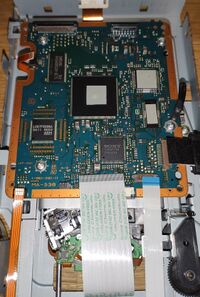
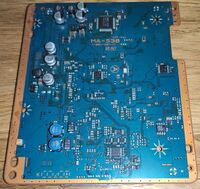
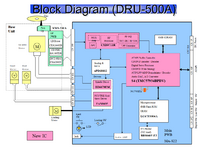
Block diagram of closely related sony drive DRU-500A using the exact same chipset and optical pickup above.
- Digital
- Texas Instruments S4 TMC57934APDV (EnDec, Servo-DSP, ATAPI-interface)
- Sanyo LC67F5006A (ARM7TDMI-based microcontroller with 6 Mbits of Flash-ROM and 256 Kbits of SRAM)
- Stores the drive firmware inside its Flash-ROM
- ROM and Flash
- Rohm BR9040F (chip marking: 9040) (Serial EEPROM, 4 KBits / 512 Bytes, organized 256x16) (holds calibration/configuration data)
- DRAM
- Samsung K4S640832H-UC75 (133 Mhz SDRAM, 8 MBytes, organized 8Mbits x 8)
- Analog + Digital
- Analog
- Rohm BD6670FM (3-Phase spindle motor driver for CD-RW)
- Fairchild FAN8035L (6-CH Motor Driver, used as driver for focus, tracking, tilt, sled)
- ST KF25 (2.5V low drop voltage regulator)
- On the pickup:
- Sony CXA2640ER (laser diode driver)
- Sony CXA2641N (DVD detector PDIC)
- GA100TBR (CD detector PDIC)
- ?? (DVD front power monitor PDIC)
- ?? (CD front power monitor PDIC)
- ?? (CD laser diode; internal power monitoring photo diode is unused; external front power monitoring PDIC does power monitoring instead)
- Specs for reading: 790 nm at 1.55 mW to 1.65 mW (measured on top of the whole pickup, not directly at the LD)
- Specs for writing: 790 nm at 31.75 mW to 33 mW (measured on top of the whole pickup, not directly at the LD)
- ?? (DVD laser diode; internal power monitoring photo diode is unused; external front power monitoring PDIC does power monitoring instead)
- Specs for reading: 660 nm at 0.72 mW to 0.78 mW (measured on top of the whole pickup, not directly at the LD)
- Specs for writing: 660 nm at 11 mW to 12 mW (measured on top of the whole pickup, not directly at the LD)
Integrated Circuits (MA-S43, used in DESR-x500 and DESR-x700)[edit | edit source]
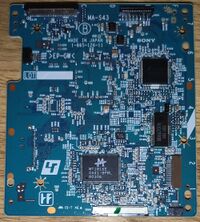
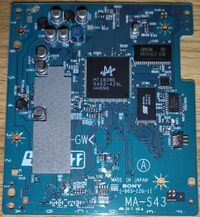
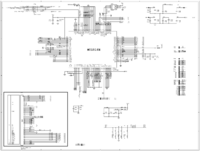

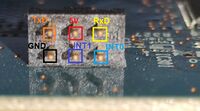
Pinout of debug header above (directly connected to MT1828E). LiteOn PC DVD drives and their Sony OEM equivalents using the same chipset also have a debug connector with this pinout.
- Digital
- IC402: Fairchild 74VHC157M (Quad 2-Input CMOS Multiplexer)
- IC603: Mediatek MT1828E (main DVD-drive/burner controller, includes microcontroller/s, DSP, EnDec etc., no public datasheet available)
- Pinout available from some PC DVD drive's schematics
- Has an 80C32/MCS-51 8-Bit microcontroller core as other Mediatek chipsets from that time do.
- Has a debug header on board; see above for pinout
- ROM and Flash
- IC102: Rohm BR93L66 (chip marking: RL66) (Microwire serial EEPROM, 4 KBits / 512 Bytes, organized 256x16) (holds calibration/configuration data for MT1816E)
- IC302: SST 39VF080 (Flash ROM, 1 MByte / 8 MBits, organized 1Mx8) (updatable firmware for MT1828E)
- DRAM
- IC303: Samsung K4S161622E-UC80 (125 Mhz SDRAM, 2 MBytes, organized 512K x 16Bit x 2 Banks)
- Analog+Digital
- Analog
- IC110: Rohm BD6670FM (3-Phase spindle motor driver for CD-RW)
- IC309: Fairchild 74HC4053A (Triple 2-Channel Analog Multiplexer)
- IC401: ST KF33 (3.3V low drop voltage regulator)
- IC403: ST KF25 (2.5V low drop voltage regulator)
- IC1000: Fairchild FAN8035L (6-CH Motor Driver)
- On the pickup:
- Elantec/Intersil EL6833CLZ (Laser Diode driver)
Notes[edit | edit source]
- Contrary to some information on the internet, the drive does NOT seem to be married to the individual console. It is however likely that you can not replace the older drive type by the newer type or vice versa (needs verification, please contribute), due to different specifications and features, despite identical electrical interfaces (which is just IDE/ATA through a 50 pin flat flex cable).
- Several variants of the Sanyo SF-DB11 pickup exist, with only some of them being compatible with the PSX. Trying to install an incompatible one will (sometimes? always?) burn the flat flex cable and/or blow the 5V drive-power fuse on the motherboard depending on your luck (known compatible variants: bottom sticker number starts with DB11B; known incompatible revisions: bottom sticker number starts with DB11N, 11NX or 11NXL). It didn't seem to damage anything else though; most notably all electronics (after replacing the blown fuse) AND the laser pickup (after being installed into a compatible PC drive that uses this variant) survived.
- These different types are seemingly actually called "SF-DB11B" (the one compatible with the PSX), "SF-DB11NS", "SF-DB11NX" and "SF-DB11NXL" (all three incompatible with PSX). These are best differentiated by the bottom sticker, not by the embossed revision number on the top.
- Symptoms of a blown 5V fuse:
- Drive appears dead (the slot-mechanism however still works and correctly pulls in and ejects discs)
- When forcing the console into PS2 mode through FMCB, inserting a disc will cause the PS2-laser to start focussing since it runs from another power source, however, the spindle motor will not spin
- The front USB port does not work
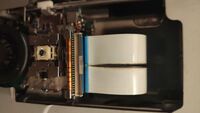
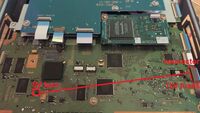
- Comparison of an compatible type (left) with an incompatible type (right) of SF-DB11 with the bottom shielding removed. Note the missing potentiometers for setting the oscillator frequencies on the incompatible type, where fixed 680 Ohm resistors are used instead:
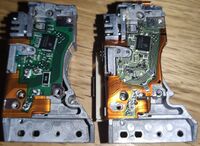
- There is an official documentation of the KWS-200A used in the DESR-x000 and DESR-x100 PSX, released by Sony itself, however, both power monitoring PDICs are absent in the drawing:
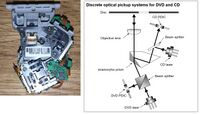
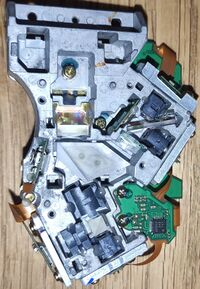
Motherboards[edit | edit source]
XPD-001[edit | edit source]
- Year 2003 - 2004
- Models DESR-5000, DESR-7000, DESR-5100, DESR-5100S, DESR-7100
- Chassis X
- Both PSX motherboards have a total of 64 MB RDRAM (physical ICs: 72 MB, but not fully utilized), unlike normal PS2s' 32 MB
- Both PSX motherboards have a total of 8 MB EDO-RAM for IOP, unlike normal PS2's 2 MB
- Known sub-revisions:
- -21
XPD-005[edit | edit source]
- Year 2004 - 2005
- Models DESR-5500, DESR-7500, DESR-5700, DESR-7700
- Chassis X
- Both PSX motherboards have a total of 64 MB RDRAM (physical ICs: 72 MB, but not fully utilized), unlike normal PS2s' 32 MB
- Both PSX motherboards have a total of 8 MB EDO-RAM for IOP, unlike normal PS2's 2 MB
- Compared to XPD-001, this board has several more daughter boards:
- One large daughter board (XRC-005) with analog video interfaces as well as the Ethernet transceiver (the much smaller XRC-001 in XPD-001 consoles only contains the s-video/composite input/output ports)
- One smaller daughter board (XCP-005) with one the console's two SPEED chips, an unknown Pioneer chip (PE7003D) and an Altera FPGA (with it's configuration EEPROM and a programming header)
- The FPGA likely does AVC/H264 encoding for the PSP/MS video export feature
- A similarily named Pioneer chip (PE7005A) is found in some Pioneer DVR (DVR-920H-S), where it is labelled as an I/O expander in the service manual
- DESR-7500 and DESR-7700 also have an additional third daugher board (XDV-005) on the opposite side of the main board, which contains the iLink-interface controller
- Some, but not all XPD-005 boards have a small pcb (XDI-002) with a few components soldered with two wires directly to the motherboard. Boards without this additional board have a small MLCC on these pads.
- This board also contains 2 LEDs connected to DVRP which are invisible from the outside but light up when the console is powered on. It is not known what is indicated by these LEDs.
- Known sub-revisions:
- -11
- -21
- -22
Integrated Circuits (XPD-001)[edit | edit source]
General ICs[edit | edit source]
- Texas Instruments F741580AGGB
- Memory Stick controller
- Probably an off-the-shelf part with a custom label by sony as well as possibly a custom internal ROM
- Has a dedicated NOR-flash located on the other side of the motherboard containing its firmware (Fujitsu MB85431BC)
- Probably also functions as some kind of SysCon/SMC, controlling LEDs, IR-receivers etc (needs verification; this might as well be handled by Mechacon and/or IOP)
- Related IC is used in some VAIO-Notebooks (PCG-V505BL/V505BX/V505BXP) with an internal Memory Stick reader, where it's called "SUMIRE2" in the schematics
Audio/Video ICs[edit | edit source]
ROM and Flash[edit | edit source]
- Fujitsu MB85431BC
- NOR-Flash
- Firmware for F741580AGGB (Memory Stick controller)
- Fujitsu MB85432BF
- NOR-Flash
- Firmware for DVRP; also contains 2 more firmware blobs for other devices
- This is a custom part number by Sony, but the chip seems to match with the Fujitsu MBM29LV320BE, which is a 32 Mbit Flash
- Samsung K9F6408U0C-QCB0
- NAND-Flash (8 MBytes)
- PSX firmware (xfrom:/)
- SCEI XB00-010
- Mask-ROM or OTP-ROM (4 MBytes)
- PS2 BIOS
- ST M93C46 (chip marking: C46WP)
- Microwire EEPROM (1 KBits/128 Bytes)
- Connected to CXD9764GP (DVR-SPEED)
- MAC Address and checksum
DRAM[edit | edit source]
Integrated Circuits (XPD-005)[edit | edit source]
General ICs[edit | edit source]
- Texas Instruments F741580AGGB
- Memory Stick controller
- Probably an off-the-shelf part with a custom label by sony as well as possibly a custom internal ROM
- Has a dedicated NOR-flash located on the other side of the motherboard containing its firmware (Fujitsu MB85431BC)
- Probably also functions as some kind of SysCon/SMC, controlling LEDs, IR-receivers etc (needs verification; this might as well be handled by Mechacon and/or IOP, please contribute)
- Related IC is used in some VAIO-Notebooks (PCG-V505BL/V505BX/V505BXP) with an internal Memory Stick reader, where it's called "SUMIRE2" in the schematics
Audio/Video ICs[edit | edit source]
ROM and Flash[edit | edit source]
- Fujitsu MB85431BC
- NOR-Flash
- Firmware for F741580AGGB (Memory Stick controller)
- Fujitsu MB85432BF
- NOR-Flash
- Firmware for DVRP; also contains 2 more firmware blobs for other devices
- This is a custom part number by Sony, but the chip seems to match with the Fujitsu MBM29LV320BE, which is a 32 Mbit Flash
- Samsung K9F6408U0C-QCB0
- NAND-Flash (8 MBytes)
- PSX flash for BootLoader (xfrom:/)
- OKI MR27V3202F (printed on chip: R27V3202F)
- One-time programmable ROM (4 MBytes)
- PS2 BIOS
- ST M93C46 (chip marking: C46WP)
- Microwire EEPROM (1 KBits/128 Bytes)
- Connected to CXD9764GP (DVR-SPEED)
- MAC Address and checksum
DRAM[edit | edit source]
Power Supply[edit | edit source]
| Wattage | approx. 96 - 108 W |
| Output voltage | 12 V |
| Max output amperage | 8 to 9 A (unconfirmed) |
| Input voltage | 100 V (Japan) |
| Input frequency | 50 / 60 Hz |
Interface[edit | edit source]
(DESR-7500) 1x4 Through-pin socket. Two pins +12V, two pins ground. Pins closest to the corner of the board are +12V. No special signalling seen.
Models[edit | edit source]
It seems that 1-468-805-xx and 1-468-806-xx are for PSX1 (XPD-001 motherboard) while 1-468-868-xx and 1-468-869-xx are for PSX2 (XPD-005 motherboard).
Nichicon[edit | edit source]
- ZSSR343JA (100 V); Sony part no. 1-468-805-11 for PSX1/XPD-001
- ZSSR414JA (100 V); Sony part no. 1-468-868-11 for PSX2/XPD-005
- ZSSR414JA (100 V); Sony part no. 1-468-868-12 for PSX2/XPD-005
Matsushita/Panasonic[edit | edit source]
- ETXNY499J9A (100 V); Sony part no. 1-468-806-11 for PSX1/XPD-001
- ETXNY499J9AA (100 V); Sony part no. 1-468-869-11 for PSX2/XPD-005
- ETXNY499J9AA (100 V); Sony part no. 1-468-869-12 for PSX2/XPD-005 (on some units, the 2 at the end of the part no. has been re-printed over a 1)
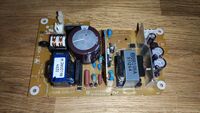 |
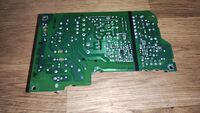
|
| DESR-7700 Matsushita power supply (front). | DESR-7700 Matsushita power supply (back). |
Downloads[edit | edit source]
Manuals for PSX:
- https://www.sony.jp/ServiceArea/impdf/sc-smc-sc-8154.html
- https://www.mediafire.com/file/fk09397k0hedwu6/2022649012.7z (Mirror)
Specifications[edit | edit source]
| Models |
DESR-5000 |
| HDD |
160GB |
| Recording Mode |
HQ |
| CPU GPU | 90nm EmotionEngine+Graphics Synthesizer |
| Software Engine | PS2 based real time OS |
| Recording Format |
DVD-R(Video format) |
| Playback Format |
DVD-VIDEO |
| Tuner |
Terrestrial analog(VHF1-12ch,UHF13-62ch,CATV13-35ch) |
| Dubbing | HDD to DVD is 12 times maximum (-R) |
| Video Playback | Recorded program while recording on HDD |
| Video Editing |
GOP Editing |
| Timer | EPG(G Guide) |
| Photo | JPEG |
| Music | ATRAC3 |
| Game | "PlayStation" software / "PlayStation 2" software |
| Network |
Ethernet 100 base/TX |
| Ports |
1 D output(D1/D2) |
| Dimension | 312 x 323 x 88mm(W x H x D) |
| Weight | ~5.5kg for first gen models. ~6.5kg for second gen models |
| Accessories |
Remote Controller for PSX |
CEATEC Japan 2003[edit | edit source]
Sony showcased the PSX at Japan's CEATEC in 2003, here are images of the event:
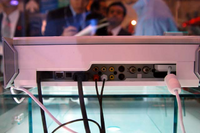
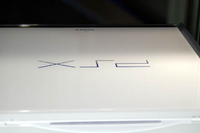
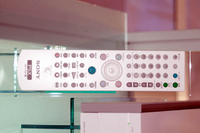
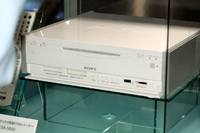

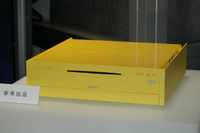
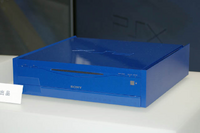
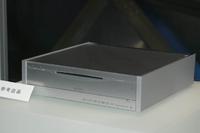
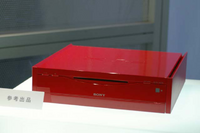
Resources[edit | edit source]
PSX at PC Watch(Japanese Site)
Archived Sony Press Release
Sony PSX DVR(Fan Site)
